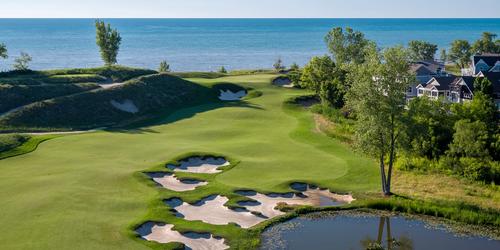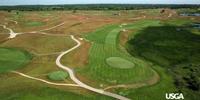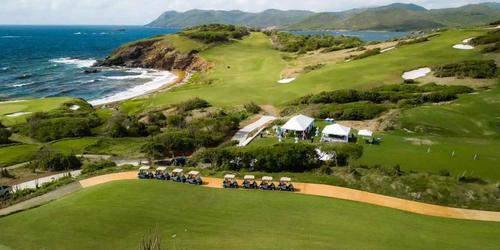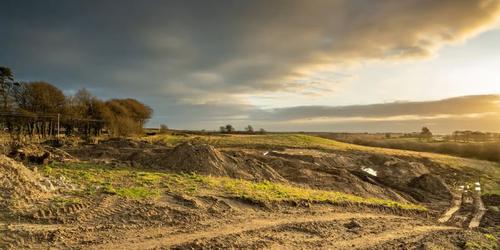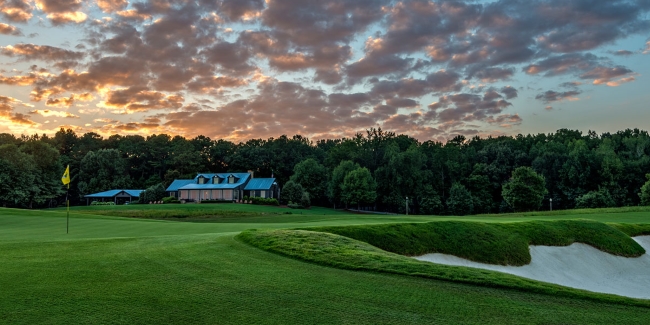
Postcards from The Warmth of Spring: Sweet Home Alabama
Distinctive Destination
By Matt Tevsh
Midwest Golfing Magazine traveled south earlier this year and along the way found a lucky penny, met Stark the German Shepherd, and ate $2.99 barbecue pork sandwiches.
The weathermen call it an Alberta Clipper. Really it just means more snow could be coming. A "clipper" system is the last thing anyone in the Midwest wants to hear about during the first week of spring. But in this case, the timing was perfect.
As heavy, wet flakes fell across Wisconsin and northern Illinois, Midwest Golfing Magazine's Glen Turk and I traveled to Alabama for a much-needed golf trip to wake up from hibernation. By the last two days it was 75 degrees and sunny and the courses were starting to dry out from a wet stretch of weather. Tee shots were running out and the dormant grasses were starting to green ever so slightly. How many days until the Masters Tournament?
Like Augusta National, the last stop on our trip was as transformative as it was pure. After playing several courses on the famous Robert Trent Jones Trail, playing one off of it (Timberline in Calera) and touring another on our way out (Cider Ridge in Oxford), we settle down from our aggressive itinerary at Pursell Farms in Sylacauga. We arrived in the dark of night but in the days after we realize we're in the middle of rural Alabama right down to the stray horned sheep we see roadside, dozens of miles from our base.
The entrance to the property at Pursell Farms sets the feel. Longhorn cattle graze and a wooded portion of the drive leads to a village of sorts. Pursell Farms is not only a playground and a retreat for its guests but also for its livestock and wildlife. All told, they have 3,500 acres of lakes, mountains, fields and forests. They have historic spots, host weddings, offer hunting and fishing and horseshoes, and have cabins and cottages - enough to host large groups.
We make our two-night home in the Ross Cottage on Architects Circle. The cabins are on Masters Row. Our view off the back porch is of the fairway on No. 18, a lengthy but straight-forward par-5 framed by two large oaks. They call the course FarmLinks. How fitting.
Opened in 2003 with the purpose of being the world's first agronomic research and demonstration golf course, FarmLinks has come a long way in a short time. The Pursell family's background in the fertilizer business still makes it an educational meeting ground for course superintendents around the country, but since, the evolution of FarmLinks has taken on more luxurious amenities and hospitality. Those elements are evident even if the various grasses planted on the course for testing purposes may not be to the untrained eye.
We play two rounds at the Michael Hurdzan/Dana Fry layout because one on Alabama's top public-access course (Golfweek, 2014) is not enough. Hole No. 5, aptly nicknamed "Hang Time" is the most memorable hole. From the "longhorn" tees (total length 7,444 yards) it plays 210 yards with a 170-foot drop from tee to green. So, the hole plays much shorter. The staff at FarmLinks even goes as far as posting the adjusted yardage for each of the five tee boxes to aid with club selection. The same applies for three other downhill par-3s on the course including No. 17, a short tee shot over a lake that has an Augusta-like feel to it.
In two rounds, we miss the greens on No. 5 and No. 17 only once between the two of us. Perhaps the best part of FarmLinks is that while it can challenge low handicappers (it stood up to the field for the 2011 Alabama State Amateur), it's simple enough in its design and completely playable for the higher handicapper. The fairways are wide, the hazards are few, and the greens are far from tricked up. The par-3 holes look long but play short. And three of the par-5s offer legitimate birdie chances from the middle tee boxes.
During our stay at FarmLinks, we tour the 14,000-square foot Parker Lodge, which is visible high above the green at No. 17. Among a killer screen porch overlooking the green and eight deluxe suites a stuffed grizzly greets guests in the great room. With the touch of a button, it will even roar.
Before heading out we also stop at Hamilton Place, an Antebellum home (built in 1854) on the National Register of Historic Places, and take in a view from a mountain top about 1,900 feet above Pursell Farms. There are plans to make the spot available for special events.
A final lunch on the clubhouse patio overlooking the 18th green gives us a reminder of what FarmLinks at Pursell Farms is all about. Banjo music is playing softly from the speakers attached to the covered cart staging area (equipped with ceiling fans!). A young child frolics on the Adirondack chairs. Stark the German Shepherd faithfully runs alongside the maintenance carts with the agronomy team. And one last rooster sandwich, sweet potato soup on the side and some pig candy before hitting the road because a visitor always has to partake in some specialty fare.
Robert Trent Jones Trail Blazing
Golf can be as much about luck as skill. So to me this was a sign. On the second day of our trip, after having a quick breakfast sandwich in the clubhouse at Grand National in Auburn/Opelika, I find a penny walking down the clubhouse steps. It sticks out like a sore thumb against the white concrete. I pick it up and see that the year on it is 1986. "Huh," I say to Glen. "That's the year Nicklaus won his sixth Masters. I think I'll keep it."
We then head to the 18-hole Short Course (par-3s only) at Grand National for a time-saving morning round before traveling to Prattville to play at Capitol Hill. Glen told me on the flight out that he had a premonition I was going to get a hole-in-one on the trip. Unfortunately that does not happen but on this day we both come as close as possible. Tap-in range. Birdies are plentiful just like they were for Nicklaus during his back-nine charge on Sunday at Augusta nearly 30 years ago. The under par scoring - if only temporary - gives us a good feeling headed into our afternoon round. Jack always says tee it forward.
The short courses on the Trail are no pitch-and-putt jokes (Grand National has six holes that can play over 200 yards; we pick a different tee box each hole). They mimic much of the style of the big courses and are a great alternative for a first or second 18 when the legs or back may need a little break. Seven of the 11 Trail sites have short courses.
The only short course we play on our trip offers maybe the most enjoyable round despite the overcast conditions. Playing Grand National's Lake Course, however, is close. In 2015, it hosts a new PGA Tour event and should provide a stern challenge. Its greens seem to be divided into four or five little sections on each hole. The coolest part of the course might be the multiple views of perched greens across the amebic Sougahatchee Lake. Though the routing is expected to be different for the Tour boys, the par-3 peninsula green at No. 15, which plays 230 from the tips, makes for one of the most intimidating holes on the Trail. And believe it or not the Links course at Grand National, which hardly looks "linksy" at all and has a par-3 that can play 260 yards with little to no bailout room.
The staff is accommodating at Grand National. On a drizzly day with temperatures in the upper 50s the ranger, unprompted, brings us extra towels. We need them especially for the mud balls. Combined with the soggy turf, it's "like hitting a wet diaper," Glen says. As we leave we tell one of the cart attendants were headed to Capitol Hill. He tells us that we need to play "The Judge" there. As a first timer to the Trail, there's no way of knowing what I'm getting into.
The Long and Short of It
Looking out our hotel room window at the Marriott, I'd swear we were at Turnberry in Scotland. The Senator Course at Capitol Hill is a classic links design with holes designed through chutes of mounds. We can view No. 17 which also resembles some of the features of No. 18 at Whistling Straits back home.
Upon several recommendations, we play the Judge Course. It's probably the trickiest and toughest course on the trip (even from the middle tees it plays to a rating of 71.7 with a slope of 131). Hole No. 1 is perhaps the most photographed hole on the Trail, a par-4 with an elevated tee shot rivaling FarmLinks No. 5. Except on this tee shot the fairway narrows. When we get to No. 10, we play through a foursome of vacationers who watch us hit our semi-decent tee shots and ask, "Why aren't you playing the back tees?" This is why: As if the front nine didn't humble us enough, holes 10-12 on the scorecard play 711, 478, and 231 yards. This is the anti-short course. We stick to the 6,517-yard orange tee markers and find the holes challenging enough.
Remember the lucky penny? I still have it with me. This time we gather good fortune at the local Jim 'N Nick's Bar-B-Q just down the road. On this particular date they are celebrating their 30th anniversary and as such are offering pork sandwiches at 1985 prices. Hungry from a full day of golf we kill some cheese biscuits as an appetizer and then of course grab sandwiches for just $2.99 each. Talk about competing with Augusta's pimento cheese sandwiches? How many days until the Masters again?
Those same cheese biscuits, doggy-bag style, serve as our breakfast the next morning. We check out just after 7 a.m. to make our early morning tee time at Oxmoor Valley in Birmingham over an hour's drive away. Oxmoor is the first of the Trail sites built over 20 years ago. We play with a regular, Charlie Thompson, a transplanted Californian who plays almost every day. His local knowledge is invaluable as are his ball-finding skills. But the images that resonate most on the Ridge Course are the giant shale rock formations, the train railway that runs alongside the course and homes atop the ridge that are visible from almost anywhere on the course. Oxmoor has its own character not to mention its place in history along the Trail.
In the afternoon we make the short ride (five minutes) to Hoover to play Ross Bridge, a former Champions Tour stop. On our trip this is the most upscale property, affiliated with Renaissance Hotels. We find a kindred spirit in playing with pro Nate Lilley, an Indiana native who, like us, has not played an 18-hole round in months because the last thing most club pros do is play actual rounds of golf. With the energy of a good player in our group, shots start to go a little straighter and longer. We need that, too. Though we are again not playing from the back tees, Ross Bridge boasts itself as one of the longest courses in the world at nearly 8,200 yards from the tips. They have a par-3 (No. 4) that conjures up images of Medinah and the approach shot at No. 8 looks like the approach shot at No. 11 at Augusta National. The greens are the best we play on the trip, in tip-top summer condition. So, I have no excuse for multiple three putts.
We play No. 18 just as the sun is setting. A bagpiper plays at the top of the waterfall by the ninth and 18th greens. After dinner in the clubhouse, we set off into the night for the magic that awaits us at FarmLinks the next morning.
Homebound
All told, we play 153 holes in five days, but who's counting? It feels like more than that since the wet conditions force cart path only restrictions throughout the trip. Still, we play every round in four hours or less encountering other groups from Wisconsin as we go. We play so many great holes and travel to so many different cities that I have to review my daily notes to take it all in. And still, there is so much more to play in Alabama.
The entire trip goes off without a hiccup until the very end. Our 10:05 p.m. flight out of Atlanta gets delayed a half hour. Weary from our travels and the effects of marathon golf, this could be a source of frustration. But the delay gives us just enough time to watch the end of a victory for our beloved Wisconsin Badgers in the Sweet 16 round of the NCAA Tournament. How convenient.
On the descent into Milwaukee from my window seat in the fourth row precipitation is whizzing by, illuminated by the aircraft's wing lights. Snow is falling and the courses here will be closed tomorrow. How fast can we get back to Alabama?
For more information on how you can plan a memorable trip like ours, visit www.alabama.travel Yes, that is not a mistake - they are so special they do not need the .com.
Revised: 11/04/2015 - Article Viewed 29,203 Times
About: Matt Tevsh
![]() Matt Tevsh has been a freelance sports journalist since 1996. He has been published in multiple periodicals including Midwest Golfing Magazine and on various websites including GolfTrips.com. He is an avid golfer and a former member of the Golf Writers Association of America.
Matt Tevsh has been a freelance sports journalist since 1996. He has been published in multiple periodicals including Midwest Golfing Magazine and on various websites including GolfTrips.com. He is an avid golfer and a former member of the Golf Writers Association of America.





